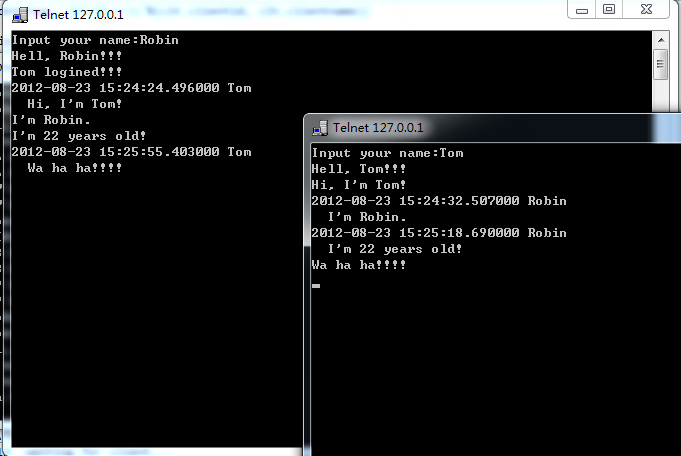Python实现的使用telnet登陆聊天室实例
本文实例讲述了Python实现的使用telnet登陆聊天室。分享给大家供大家参考。具体如下:
前久在家学习Python的时候写的一个简单的聊天室,可以使用telnet来登陆。
遗憾的是现在对中文的支持很差,英文聊天倒是没什么问题了。
功能很简单的,应该没有你想象的那么强大,但是你如果有兴趣的话可以试试的。
另外,让我惊奇的是它可以在Android的平板上运行SL4A的Python解释器上运行(需要稍微改几句代码,貌似是编码的那个地方,我记不清了)。
现在这个是可以在PC上跑起来的。
废话不多,直接放代码了,就一个py文件而已,而且注释是乱七八糟的,编码风格也不好(好神似我在用类C语言的习惯)。
# Filename: ChatRoomServer.py
import threading
import datetime
import socket
# a simple log function
def log(lg):
print(lg)
# Chat room server listen thread class, this class is use for listening client login
# when a client request to connect server, this class will start a connect thread
class ServerListenThread(threading.Thread):
def __init__(self, hostname, port, accept):
threading.Thread.__init__(self)
self.hostname = hostname
self.port = port
self.accept = accept
self.sock = socket.socket(socket.AF_INET, socket.SOCK_STREAM)
self.sock.setsockopt(socket.SOL_SOCKET, socket.SO_REUSEADDR, 1)
self.sock.bind((hostname, port))
self.sock.listen(0)
log('ServerIp:%s ServerPort:%s waiting for client...'%self.sock.getsockname())
def run(self):
clientid = 1
while True:
client, cltadd = self.sock.accept()
log('a request from Id=%s%s'%('%d Address:'%clientid , cltadd))
if self.accept(clientid, client):
clientid = clientid + 1
# Connect thread class, this class is use for connecting with client and receiving client's message
class ServerConnectThread(threading.Thread):
def __init__(self, clientid, client, encoding, receive, disconnect):
threading.Thread.__init__(self)
self.client = client
self.clientid = clientid
self.encoding = encoding
self.receive = receive
self.disconnect = disconnect
self.clientname = None
self.inputs = self.client.makefile('rb', 0)
self.outputs = self.client.makefile('wb', 0)
def run(self):
self.sendstring('Input your name:')
while True:
string = self.readline()
if string:
string = string.lstrip()
if len(string)>0:
self.receive(self, string)
else:
self.inputs.close()
self.outputs.close()
break
if self.clientname:
self.disconnect(self)
def sendstring(self, string):
self.sendbytes(bytes(string, self.encoding))
def sendbytes(self, bts):
self.outputs.write(bts)
def readline(self):
rec = self.inputs.readline()
if rec:
string = bytes.decode(rec, self.encoding)
if len(string)>2:
string = string[0:-2]
else:
string = ' '
else:
string = False
return string
# Chat room server class, this class is constitute of a listen thread and many connect thread
class ChatRoomServer:
def __init__(self, ip='0.0.0.0', port=9113, encoding='utf-8'):
self.hostname = ip
self.encoding = encoding
self.port = port
self.clients = {}
self.clientnames = {}
def whenconnect(self, clientid, client):
log('a connect with Id=%s%s'%('%d Address:'%clientid , client.getpeername()))
connect = ServerConnectThread(clientid, client, self.encoding, self.whenreceive, self.whenexit)
connect.start()
return True
def whenreceive(self, client, string):
log('frome %d, receive:%s (%d)'%(client.clientid, string, len(string)))
if client.clientname:
if string[0]=='.':
self.handlecmd(client, string[1:])
else:
now = datetime.datetime.now()
sendstring = '%s %s\r\n %s\r\n'%(now, client.clientname, string)
self.sendtoall(sendstring, client)
else:
if self.clientnames.__contains__(string):
client.sendstring('%s is exited!!!\r\n'%string)
else:
client.clientname = string
client.sendstring('Hell, %s!!!\r\n'%client.clientname)
self.addclient(client)
return True
def whenexit(self, client):
self.delclient(client)
return True
def handlecmd(self, client, cmd):
log('cmd: %s'%cmd)
if cmd=='user':
client.sendstring('User list(%d):\r\n'%len(self.clients))
for i in self.clients:
clt = self.clients[i]
client.sendstring(' %d\t%s\r\n'%(clt.clientid, clt.clientname))
else:
client.sendstring('Unknow command: %s:\r\n'%cmd)
def start(self):
serverlisten = ServerListenThread(self.hostname, self.port, self.whenconnect)
serverlisten.start()
def sendtoall(self, string, notfor):
sends = bytes(string, self.encoding)
for i in self.clients:
if not(notfor and notfor.clientid==i):
self.clients[i].sendbytes(sends)
def addclient(self, client):
self.sendtoall('%s logined!!!\r\n'%client.clientname, client)
self.clients[client.clientid] = client
self.clientnames[client.clientname] = client.clientid
def delclient(self, client):
self.sendtoall('%s logouted!!!\r\n'%client.clientname, client)
del self.clients[client.clientid]
del self.clientnames[client.clientname]
# start a chat room server
ChatRoomServer().start()
有了这个服务器程序之后就可以了(当然前提是你安装的Python解释器),没有客户端的,那么你会问怎么开始聊天呢?
下面开始介绍怎么开始聊天,首先你把这个文件运行起来,如下图可以看到服务器正在等待客户端登陆了:

客户端直接使用telnet命令登陆,注意端口应该和服务器的一样,命令为:telnet 127.0.0.1 9011,自动打开telnet控制台,输入自己的名字吧:

现在你在看看服务器端的控制台界面,可以看到记录了登陆消息:

继续使用telnet登陆另外的用户之后就可以聊天了:

功能很简陋了,不过这让我想起了二三十年前的事,嘿嘿,那时候应该就是这样子聊天的了吧,生在这个时代的我们永远都体会不到那种乐趣了。
希望本文所述对大家的Python程序设计有所帮助。
